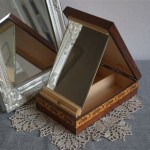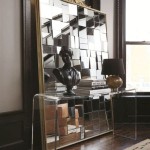Ivory Mirror Antique: A Reflection of History and Craftsmanship
Antique ivory mirrors represent a fascinating intersection of artistry, history, and material culture. These objects, often imbued with intricate carvings and reflecting a bygone era, offer a glimpse into the tastes and techniques of previous centuries. Understanding their creation, significance, and the ethical considerations surrounding them provides a richer appreciation for these unique artifacts.
The use of ivory in decorative arts has a long and complex history. Prized for its creamy white color, smooth texture, and relative ease of carving, ivory was incorporated into a variety of objects, including furniture, jewelry, and, of course, mirrors. The earliest examples of ivory mirrors date back centuries, with notable pieces originating from various cultures, including European, Asian, and African.
The creation of an ivory mirror was a labor-intensive process, often involving multiple skilled artisans. The ivory, typically sourced from elephant or walrus tusks, would be carefully selected and prepared. Skilled carvers would then meticulously shape the ivory into intricate frames, often featuring elaborate motifs such as flowers, foliage, figures, and mythological creatures. The level of detail achieved in these carvings is a testament to the artisans' expertise and dedication.
The mirror plate itself was also a crucial element. Early mirrors utilized polished metal surfaces, such as bronze or silver, but later examples incorporated glass backed with a reflective coating. The integration of the mirror plate into the ivory frame required precision and skill to ensure a seamless and aesthetically pleasing result.
Different regions and periods developed distinct styles of ivory mirror production. European ivory mirrors, particularly those from the 17th and 18th centuries, often exhibited ornate Baroque or Rococo designs, characterized by flowing lines, intricate scrollwork, and elaborate ornamentation. Asian ivory mirrors, particularly those from China and Japan, frequently featured intricate carvings of dragons, phoenixes, and other symbolic figures, reflecting the cultural and artistic traditions of these regions. African ivory mirrors, often produced for both local use and export, displayed a wide range of styles and motifs, reflecting the diverse artistic heritage of the continent.
The ownership of an ivory mirror was often a marker of status and wealth. These luxurious objects adorned the homes of the aristocracy and elite, serving both a practical purpose and as a symbol of refined taste and social standing. The craftsmanship and artistry embodied in these mirrors elevated them beyond mere utilitarian objects, transforming them into works of art.
The trade in ivory, however, has a dark side. Historically, the demand for ivory fueled the hunting of elephants and other ivory-bearing animals, leading to significant declines in their populations. Recognizing the devastating impact of the ivory trade, international regulations and treaties have been enacted to protect these endangered species. The Convention on International Trade in Endangered Species of Wild Fauna and Flora (CITES), established in 1975, plays a crucial role in regulating the international trade in ivory and other endangered species.
When considering the acquisition of an antique ivory mirror, it is essential to be aware of these ethical considerations and to ensure compliance with all relevant regulations. Antique ivory mirrors acquired before CITES regulations came into effect may be permissible to own and trade under certain circumstances. However, acquiring ivory objects post-CITES requires careful documentation and adherence to strict guidelines. It is crucial to consult with reputable antique dealers and experts who can provide accurate information regarding the legality and ethical implications of owning and trading antique ivory.
Authenticating antique ivory mirrors requires expertise and careful examination. Factors such as the age, style, carving technique, and patina of the ivory can provide clues to its origin and authenticity. Microscopic analysis can also be used to determine the species of origin and to distinguish genuine ivory from imitations. Consulting with qualified appraisers and specialists is essential for accurate authentication and valuation.
Caring for antique ivory mirrors requires specific considerations. Ivory is a sensitive material that can be damaged by excessive exposure to light, humidity, and temperature fluctuations. It is important to store ivory mirrors in a stable environment, away from direct sunlight and extreme temperatures. Cleaning should be done with utmost care, using gentle methods and avoiding harsh chemicals that can damage the delicate surface. Consulting with professional conservators is recommended for any significant repairs or restoration work.
Antique ivory mirrors offer a captivating glimpse into the past, reflecting not only the image of those who once gazed upon them but also the artistry, cultural values, and historical context of their creation. Understanding the complexities surrounding these objects, both their beauty and the ethical considerations they raise, allows for a deeper appreciation of their significance within the broader context of art, history, and conservation.

Vanity Mirror Buy White Heart Dressing Table Nestasia

Buy Large Antique Style Ivory Rectangle Wall Mirror New 2ft10 X In

White Ivory Finish Teakwood Mirror For Home Size 35 5x1 5x 27 5 Inch

Floral Antique Decorative Wall Mirror Ivory Color 12 X16 Inch Outer S Art Street

Floral Antique Decorative Wall Mirror Ivory Color 12 X16 Inch Outer S Art Street

Anglo N Hoshiarpur Ivory Inlaid Rosewood Easel Mirror Bone Inlay Furniture Dresser With

Sold At Auction A French Ivory And Bone Dressing Mirror Dieppe Mid 19th Century

Buy Art Street Floral Antique Decorative Wall Mirror Ivory Color 24 X 18 Inch By Aranaut At Low S In Paytmmall Com

Buy Saaz Cotton Wall Mirror With Boho Fringes Round Antique Frame Art Bohemian Handmade Decor For Apartment Living Room Bedroom Entryways Ivory Mm206 At Best S In Jiomart

Buy Antique Ornate Round Mirror Table Top Makeup Ivory Cast Iron In








